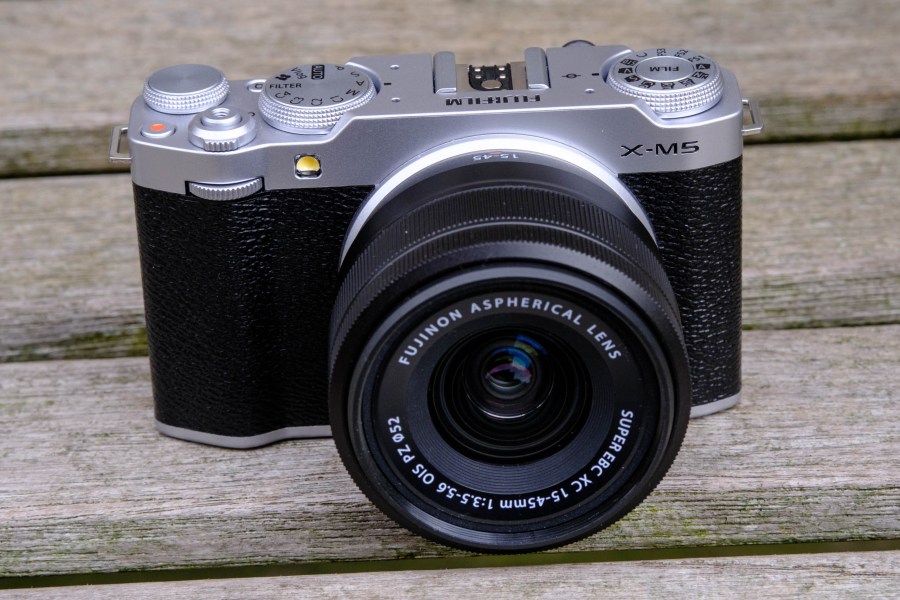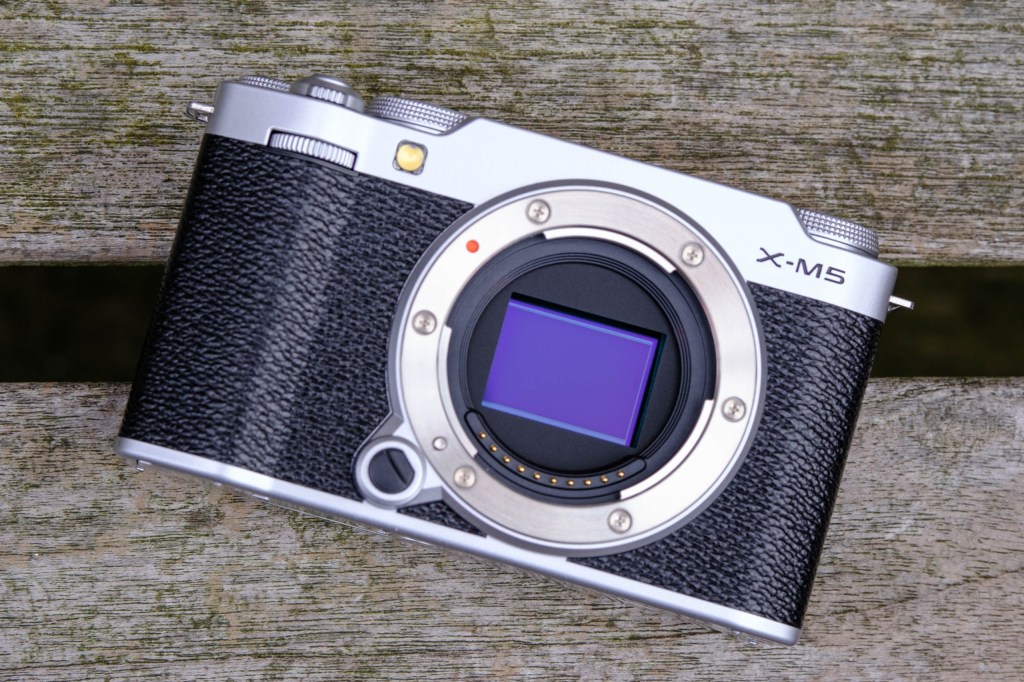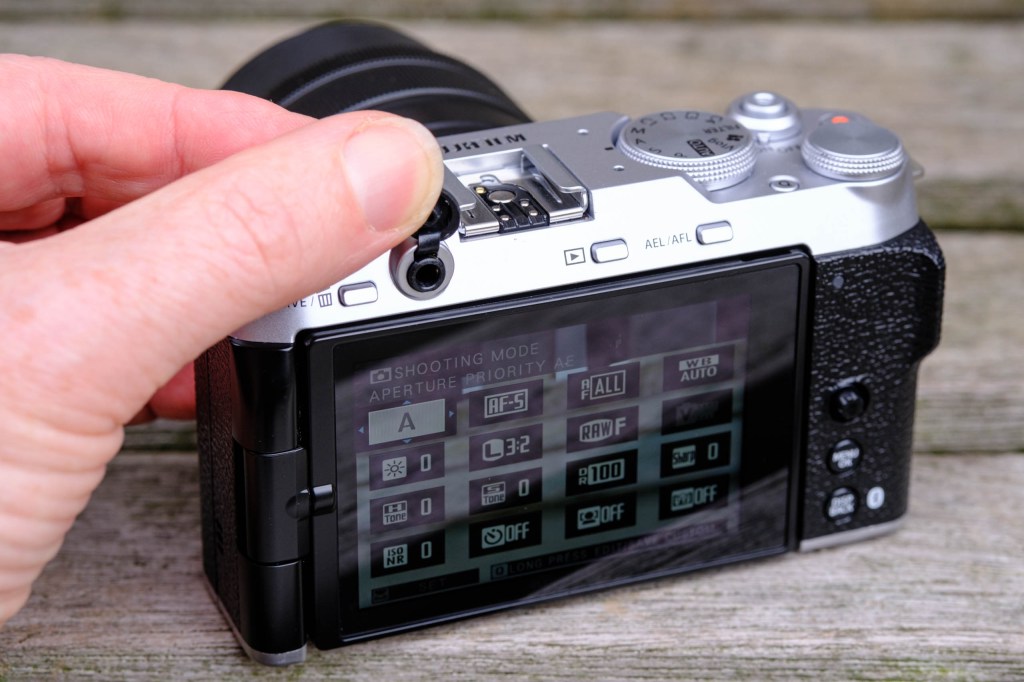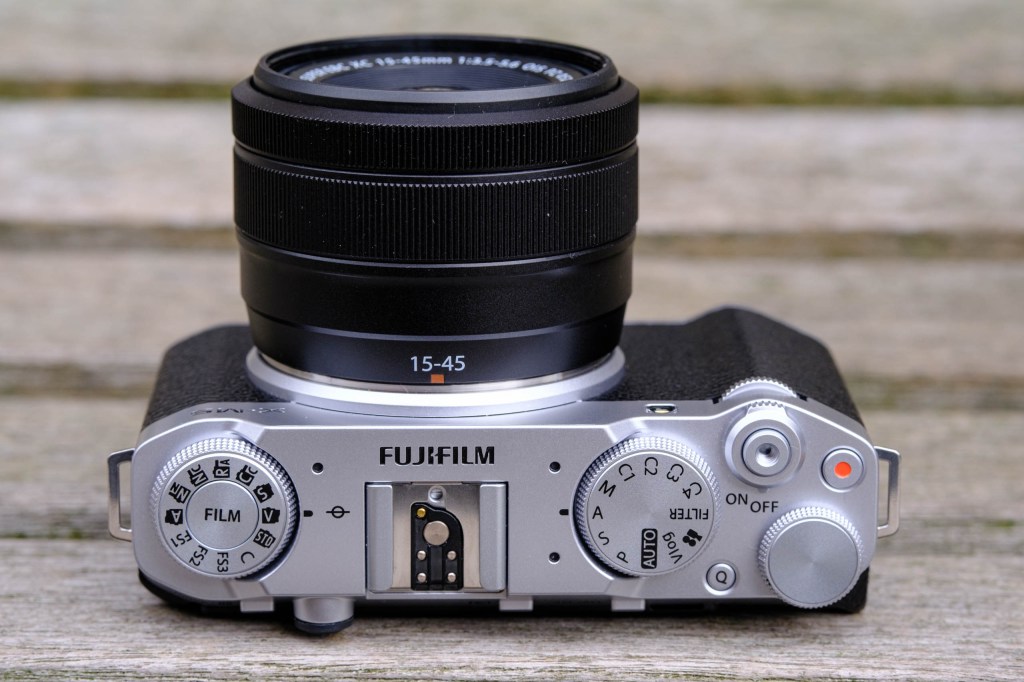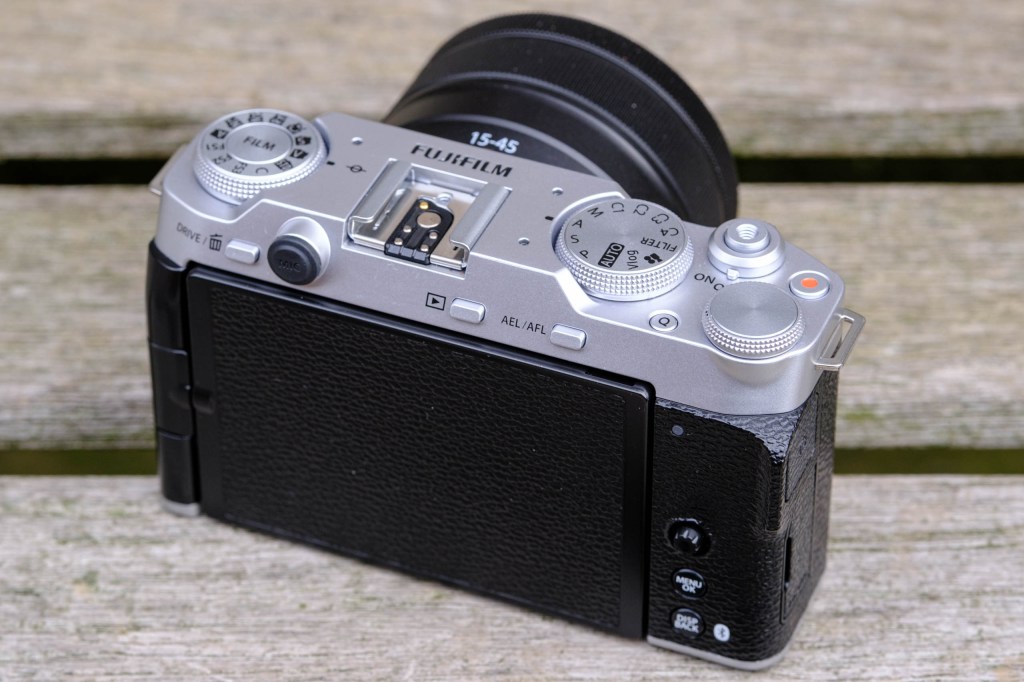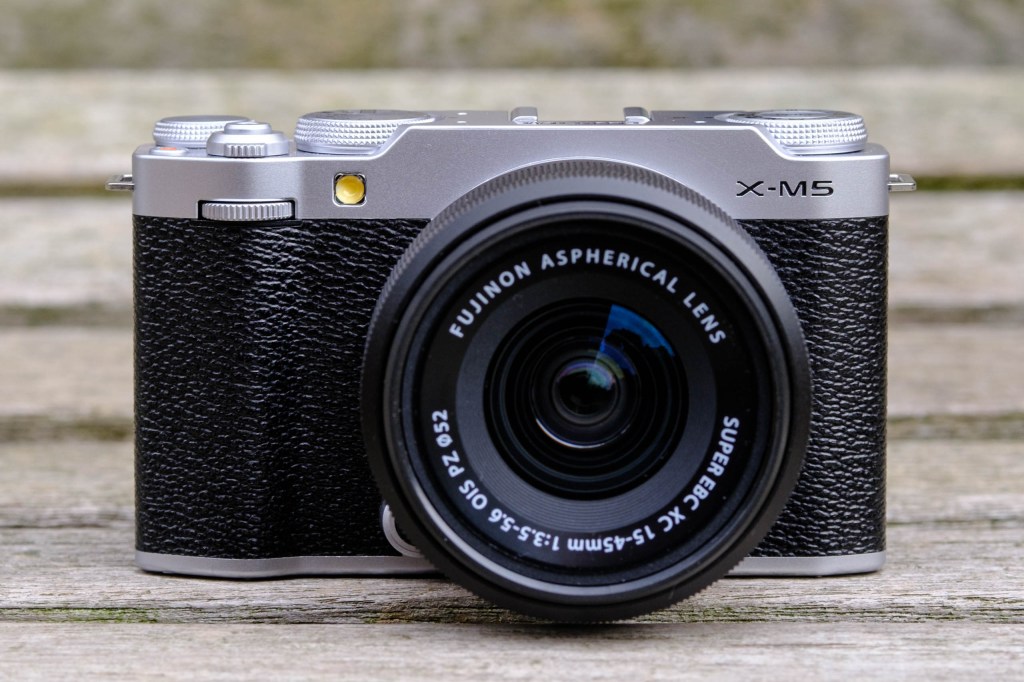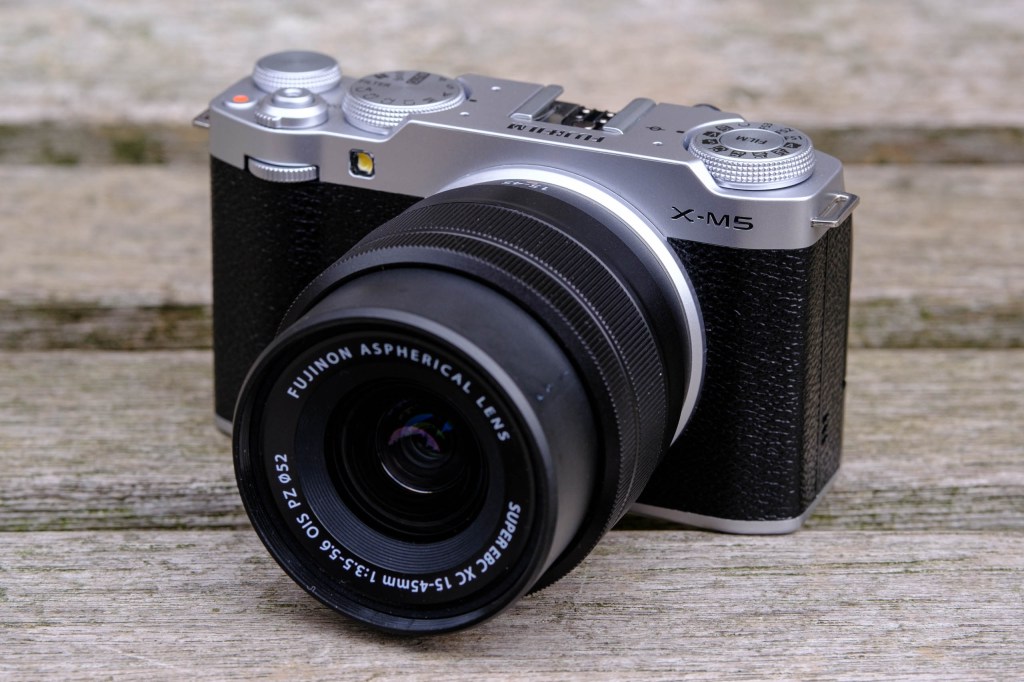Amateur Photographer verdict
A lovely little camera capable of delivering some excellent results. If you like using a viewfinder, it’s not for you, but for hybrid shooters and smartphone upgraders, it’s a well-priced winner.- Small and lightweight
- Stylish
- Fully articulating touchscreen
- 6.2K / 4K video
- Relatively low price
- No viewfinder
- Awkward with bigger lenses
Fujifilm’s latest compact, lightweight entry-level camera in its APS-C format X-system, the Fujifilm X-M5 was announced in October 2024. The firm says it’s aimed at “everyday storytellers” who are stepping up from a smartphone for the first time, and like to record both still images and video equally. At £799 body-only, or £899 with the XC 15-45mm F3.5-5.6 kit zoom, it’s one of the most affordable Fujifilm cameras, alongside the older SLR-style X-T30 II.
Fujifilm X-M5 at a glance:
- $799 / £799 body-only
- $899 / £899 with 15-45mm zoom
- 26.1MP X-Trans CMOS 4 APS-C sensor
- ISO 125-12,800 (standard)
- 8fps shooting; 30fps with 1.25x crop
- 6.2K 30p, 4K 60p, and Full HD 240p video recording
- 3in 1.04m-dot articulating screen
Design-wise, the X-M5 is a fairly simple camera, with a small, box-shaped body, no viewfinder, and a fully articulating screen. Fujifilm first used this body style with the original Fujifilm X-M1 back in 2013. There haven’t been any other X-M models in between, but instead a range of similarly styled X-A models up to the Fujifilm X-A7 of 2019.
Like the X-M1, the X-M5 employs Fujifilm’s proprietary X-Trans CMOS sensor, in contrast to the X-A cameras that used conventional Bayer-type sensors.
Unlike the superficially similar Sony ZV-E10 II, or the full-frame Panasonic Lumix S9, the X-M5 is not designed mainly as a vlogging camera. Instead it has a good set of photography features and controls, including a mechanical shutter. In this respect it’s more like the Nikon Z30 and Olympus PEN E-P7.
Fujifilm X-M5: Photo Features
While Fujifilm’s other recent models have used 40MP sensors, the X-M5 is built around a 26.1MP sensor. However, it boasts the firm’s latest X-Processor 5, which means that it shares a lot of its siblings’ latest features, including subject-detection autofocus and a full set of Film Simulation modes.
This sensor and processor combination is also employed by the Fujifilm X-S20, which sits above the X-M5 in the firm’s line of ‘hybrid’ models. So we can expect the X-M5 to deliver pretty much identical performance and image quality to the X-S20 – which means very good indeed.
In terms of photographic specifications, the X-M5 naturally has a lot in common with the X-S20. The sensor offers a standard sensitivity range of ISO 125-12,800, extendable to ISO 25,600. Shutter speeds cover 30sec to 1/4000sec, or as fast as 1/32,000sec using the electronic shutter.

Continuous shooting is available at up to 8 frames per second using the mechanical shutter, 20fps with the electronic shutter, and 30fps with the electronic shutter and a 1.25x crop.
Subject detection covers animals, birds, cars, motorcycles, bikes, airplanes, and trains. As usual for Fujifilm, human face/eye detection is also available, as a separate but mutually exclusive option.

There’s no in-body stabilisation, so the camera relies on in-lens optical stabilisation for stills, which is complemented by electronic stabilisation for video.
Fujifilm X-M5: Video features
Video features are impressive for the price, with the X-M5 capable of 6.2K 30p ‘open gate’ recording, which uses all the sensor pixels for cropping to different aspect ratios in post-production. The camera can also record in 4K at up to 60fps, or Full HD up to 240fps. Uniquely, there’s also an option to record vertical Full HD video while holding the camera horizontally.
While many of the X-M5’s video modes use the full sensor width, chances are you’ll want to enable digital stabilisation, which imposes a 1.32x crop. This will take the 15-45mm kit zoom from 23mm equivalent at the wideangle end to 30mm.
In terms of recording times, the camera should keep going for up to an hour at 25 °C and is compatible with Fujifilm’s add-on fan unit for extended durations at higher ambient temperatures.
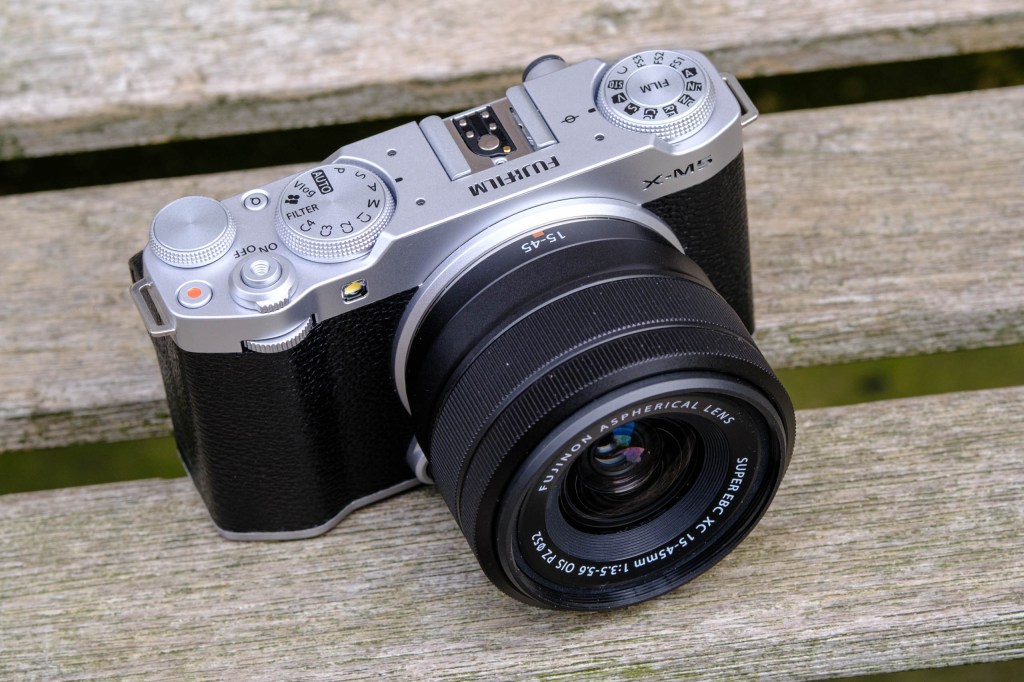
One notable new feature is the addition of a third capsule to the built-in microphone. This allows the recorded sound to be weighted in various different ways: front priority, back priority, front-and-back priority, and full surround.
Fujifilm says it has also improved the wind filter, and added a new option for suppressing continuous background noise such as air conditioning.
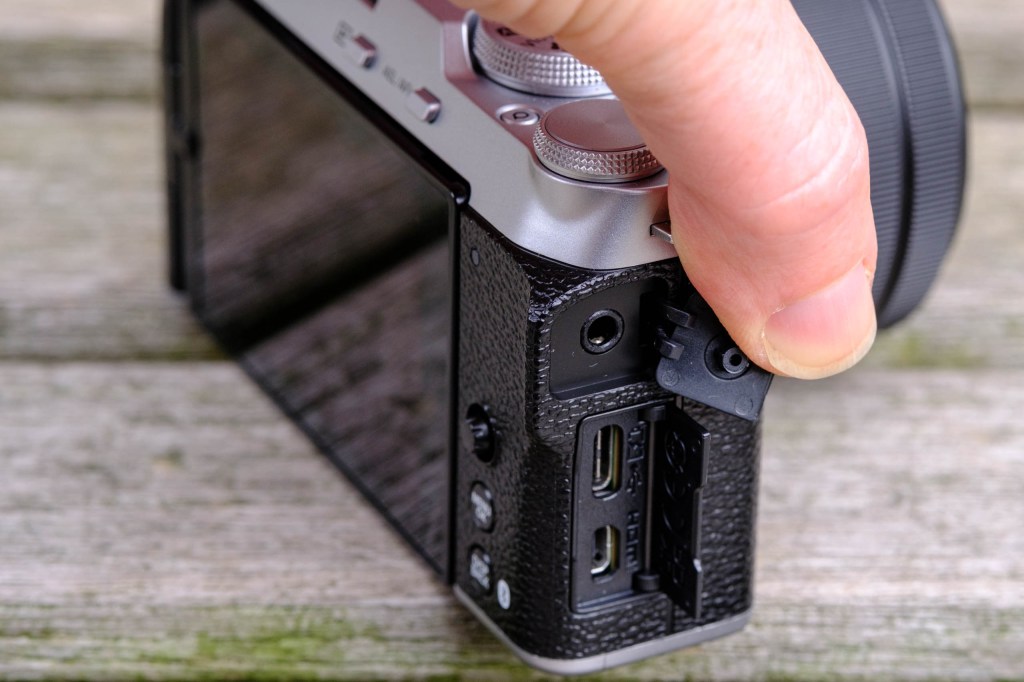
One nice touch is the inclusion of a headphone socket for monitoring audio, which is inexplicably missing from similarly shaped cameras. It’s also on the handgrip, along with the USB-C and HDMI ports, where it won’t interfere with the screen.
The XM-5 received its first software update (Ver.1.10) since its release last year. The update includes early bug fixes, and improves on SD-card compatibility and a writing error that occurred with certain SD card types. It also adds a new “Support Website” tab in the camera menu, where by scanning a QR code, you can download manuals and software updates.
Fujifilm X-M5: Key features
- Audio: The camera has three built-in mics that offer a range of directional sound recording modes.
- Video: Vlog-friendly features include 6.2K open gate recording and a unique vertical Full HD option with the camera held horizontally.
- Viewing: There’s no electronic viewfinder, with the camera relying purely on a fully articulated rear screen.
- Retail box: Fujifilm has switched to more eco-friendly packaging, with a brown box made from recycled paper that minimises ink use and has no plastic laminate.
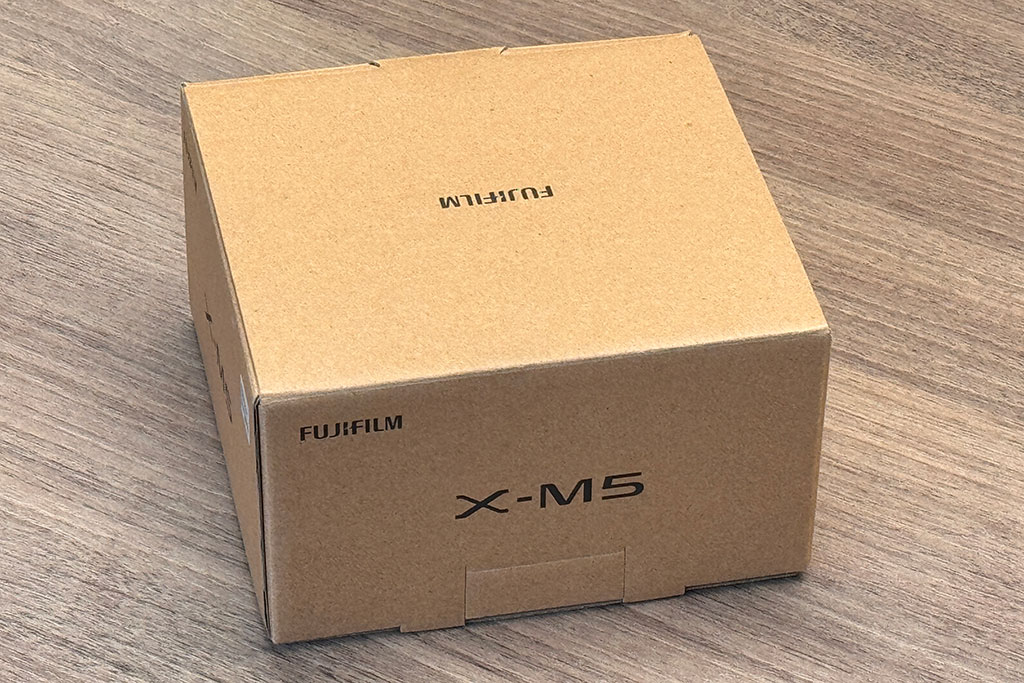
Fujifilm X-M5: Build and handling
Despite its compact size and light weight, the X-M5 handles quite nicely, thanks to a small finger grip on the front and a thumb hook on the back. I think it looks pretty stylish in its silver incarnation, although the black version is somewhat plain in comparison. But this is very much a matter of personal preference.
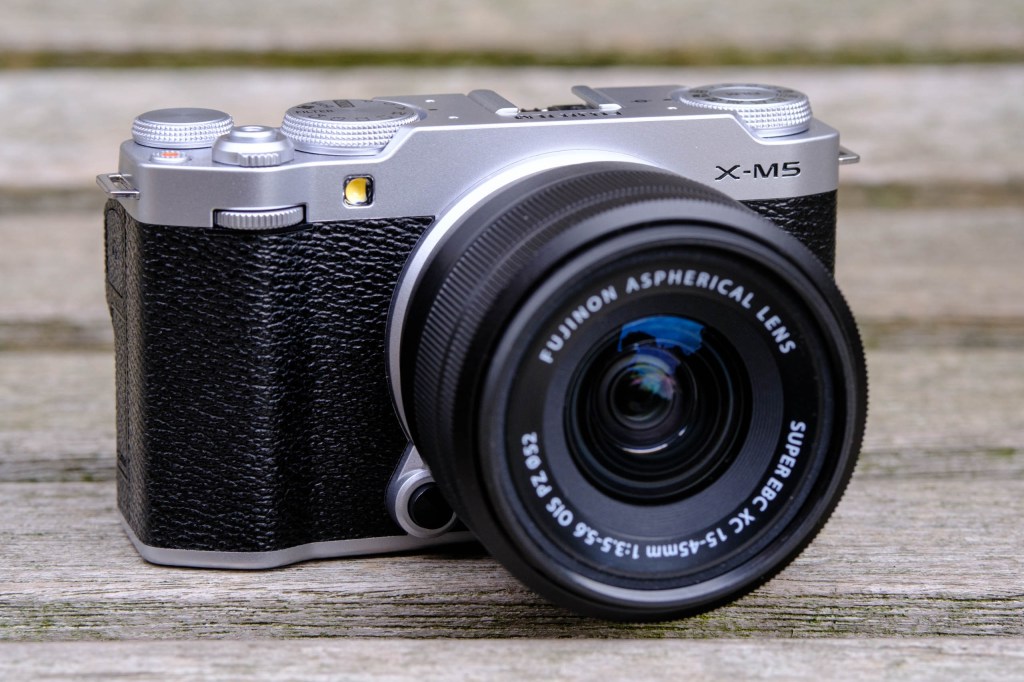
Fujifilm has made good use of the limited body space to offer a decent set of controls. You got two electronic dials to change exposure settings, front and rear, while a small joystick on the back is used to move the focus area and change onscreen settings. The front dial can be clicked inwards, which provides quick access to ISO setting.
I found this to be a little challenging to get used to, at least at first. I managed to accidentally change the ISO when I didn’t want to on a number of occasions. With time you do get used to the placement and essentially train yourself to avoid it, but it’s something to think about when first using the camera and perhaps something for those with larger hands to consider, too.
There’s a new Film Simulation dial which sits on the top left of the body. Some will like this, others will prefer an unmarked dial that could be used for other purposes. Your feelings on it likely depend on how much you tend to use the different film simulation modes. I don’t mind it, but, I rarely find myself in such a desperate hurry to change film simulations that I feel the need for a dedicated deal. It’s a good reminder to use them though, so there is that.
It is after all one of the great attractions of Fujifilm cameras that they have such excellent film simulation modes. With them you can get a good range of different looks that unlike some other brands don’t look tacky or gimmicky – they’re genuinely ones you might want to use more than once. Everybody has their favourites – I like Classic Chrome and the new Reala Ace mode, while Acros has always been a winner for black and white.
During this review, I’ve been using the X-M5 with the XC 15-45mm F3.5-5.6 lens, which you can get with it as part of a kit. This is a great pairing in terms of size, and is a good walkaround option covering a 22.5-67.5mm equivalent in 35mm terms. You can pair the X-M5 with other X series lenses, of course, but it pays to be mindful of exactly which ones to go for, as any of the larger ones will likely be a bit of an imbalance and feel awkward to use.
To that end, I also used the XF23mm F1.4 R LM WR lens with it, a prime lens giving you a 35mm equivalent. This was just about acceptable paired with the X-M5, albeit a little bit front heavy. For a similar focal length, the XF27mm F2.8 R WR lens would be a good option for keeping things as small as possible, though of course you don’t get that lovely wide aperture.
Just to see what it was like, I also used the XF70-300mm F4-5.6 R LM OIS WR lens for wildlife shots. This was pretty cumbersome, but if it’s something you’d only do occasionally, it wasn’t too awful. If you’re likely to find yourself shooting with long lenses regularly, I really wouldn’t recommend the X-M5 as the right camera for you. But it’s good to have the option nonetheless.
Fujifilm X-M5: LCD Screen
As the X-M5 doesn’t have a viewfinder, you always have to use the LCD to set up your shots. This being at the lower end of Fujifilm’s range, the screen specification isn’t as high as those found elsewhere in the range. As such, you get a 1.04m-dot screen, compared with say the 1.84m-dot device of the X-S20. The X-M5’s screen fully articulates, rather than tilts, so you can film pieces to camera, and it is touch sensitive so you can do things like change the focus point by simply tapping where you want it to be within the frame.
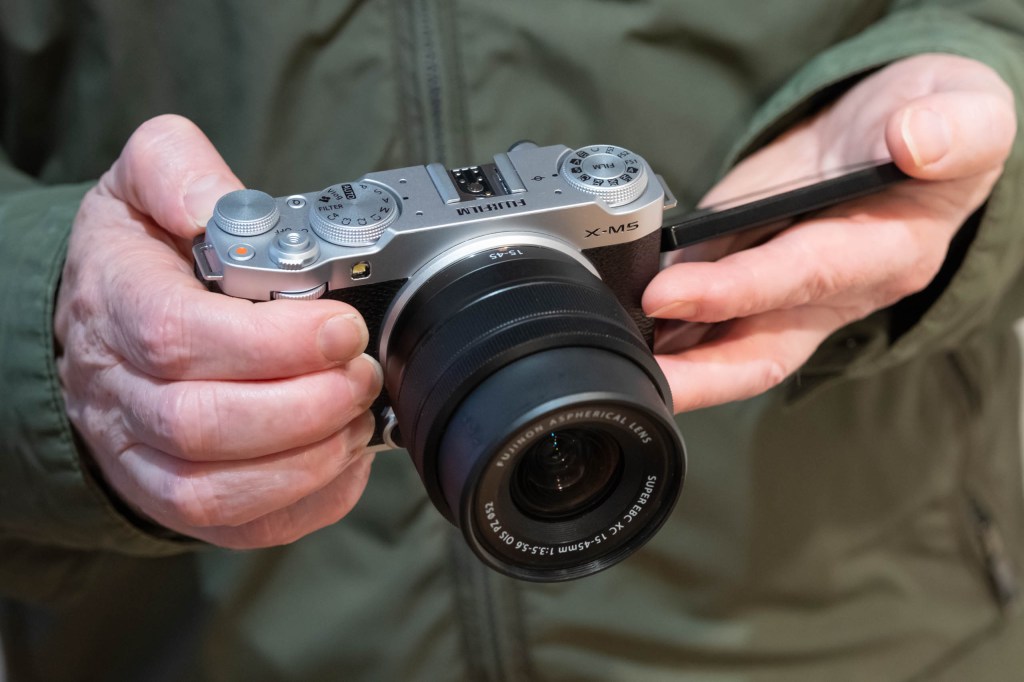
With its small, unobtrusive size, the X-M5 could arguably be a good idea for street photography. However, for this I’d prefer a tilting screen where you could hold the camera at waist level and still get a good idea of what you’re shooting – things become a little more obvious when the screen is pulled out to the side.
Video users should be pleased that the articulation hinge of the X-M5’s screen isn’t impeded by any cables that you may have plugged in, such as for a microphone. Its port is on the back of the body, while the HDMI output is on the opposite side .

The lack of a viewfinder is going to be off-putting to some, and irrelevant to others. If you’re used to shooting with a smartphone, and have perhaps never even used a viewfinder, you might not be bothered at all. Similarly, if you’re mainly shooting video, then a viewfinder (or lack thereof) simply won’t be an issue. Personally, I struggle to fully get on board with using the screen only – and in bright light it can be a little annoying trying to angle it away from glare, but that’s exactly why Fujifilm makes other models in the range that you can opt for instead if you prefer.
Fujifilm X-M5: Autofocus
As already mentioned, the X-M5 inherits many of its specifications from elsewhere in the Fujifilm range. That includes subject-detection autofocus, which covers a range of subjects including animals, birds, cars, motorcycles and bikes, airplanes and trains. You can also switch on human face/eye detection, but this is available separately and can’t be used in conjunction with the other subject detection modes.
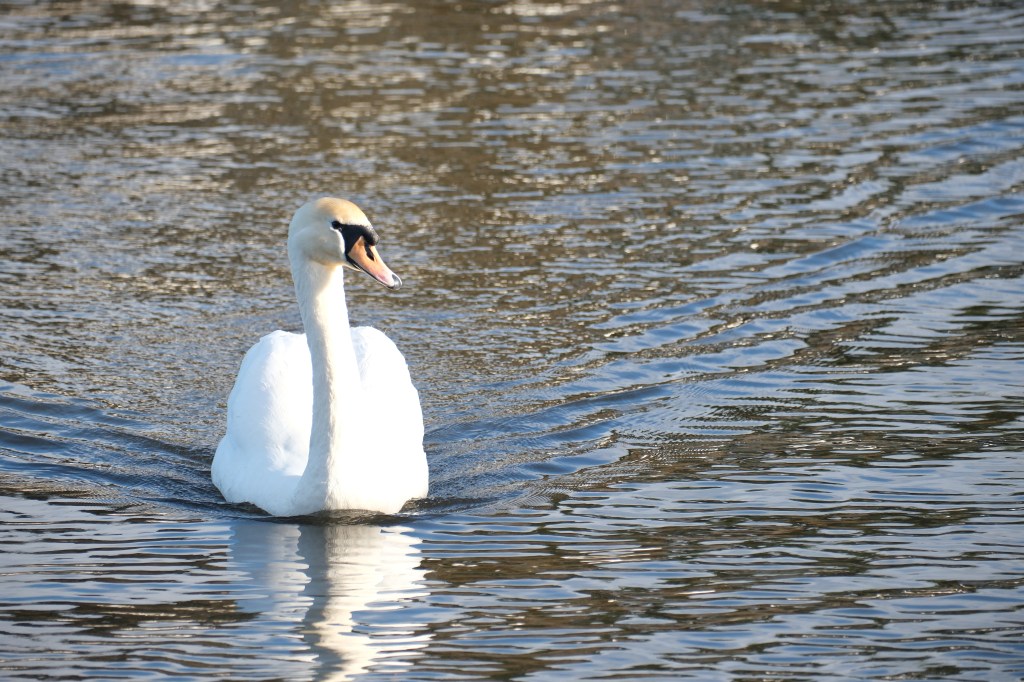
I didn’t try it with every subject listed here, but I found that it works very well for animals and birds, doing pretty well to keep up with – admittedly reasonably placid – birds flying and swimming around my local lake.
For humans, it also did very well, locking onto the eyes for portraits with great effect almost all of the time. If you have a particularly erratic subject – such as a small child – and you’re shooting in lower light, you might find the kit lens doesn’t cope as well as some of the higher-end lenses. But that would be a challenging test for even the best of cameras.

With other general shooting scenarios, such as landscapes and architecture, I found the X-M5 locked on well most of the time, too.
Fujifilm X-M5: Performance
As the sensor and processor in the X-M5 is exactly the same as that which is found in the X-S20, I knew that the image quality would be excellent. Essentially, whether you’re interested in buying this camera comes down to how you use it, not whether or not the image quality is any good – as that’s already a given.

Per Fujifilm’s usual output, the JPEG images are wonderful, with excellent colours that are consistent. Here is where your film simulation modes will be added too – I like to shoot in raw format as well so that I can go back to a “standard” look if I prefer, but I know some people who are so pleased with Fujifilm’s JPEGs that they don’t even bother to hedge their bets.

Similarly, exposures are well balanced in the majority of situations, and I rarely felt the need to dial in some exposure compensation when shooting in my favourite mode (aperture priority).

Shooting in low light yields some very good results too. You get nice and clean images up to ISO 640, and while it is obviously visible at ISO 3200 it’s not displeasing at this point. At ISO 12800 it’s a bit more apparent again, but for sharing or printing at small sizes it’s not obtrusive.
I accidentally switched to ISO 51200 on a couple of occasions when photographing my daughter at home. This is not an ISO speed I’d recommend, but even the grain in these isn’t totally offensive – so long as you accept them for what they are.

One thing to think about here is that the X-M5 doesn’t offer in-body image stabilisation, whereas the X-S20 does. That’s fair enough at this price point, but it may mean at times you need to up the ISO – again, if consistently shooting in low light is your thing, this probably isn’t the camera for you.
Fujifilm X-M5: Value for Money
You can buy the X-M5 for less than $800/£800 body only, or less than $900/£900 if you also want it bundled with the 15-45mm lens, making it one of the most affordable Fujifilm cameras you can buy right now.
If you’re keen to get into the Fujifilm ecosystem, it’s a good place to start for that reason – but you should think about exactly what you intend to do with the camera.
For those who want a hybrid model, do a lot of video shooting, or perhaps just aren’t bothered by viewfinders, it’s a good shout. However, if you lean more towards photography, then you can get the older Fujifilm X-T30 II for around the same price.
Both have the same 26MP sensor, but the X-M5 has a newer processor, giving better autofocusing, and also better video specs, such as improved 6K recording. You also get other benefits with the newer model, such as new film simulation modes. The body is also smaller and lighter, but that may not necessarily be a good thing if you miss having a viewfinder.
Looking outside of Fujifilm, there’s the recently announced Nikon Z50II (£849 body only/£999 with 16-50mm lens). Not only is this more expensive, but there’s very few APS-C lenses available for Nikon Z mount. Not to mention, the X-M5 is certainly a lot more aesthetically pleasing, so the Fujifilm has the edge for sure in this respect.
Fujifilm X-M5: Verdict
The Fujifilm X-M5 is a lovely little camera, and is capable of producing excellent results. I’m not particularly in favour of viewfinder-less cameras, but, of those of its kind, this is probably my favourite – if for nothing else than style and looks alone.
Others will be far less bothered by the lack of a viewfinder than I am, and it’s that consumer that this model is aimed at. Those who are perhaps coming over from a smartphone, for example, or those who are true hybrid shooters and are equally at home shooting video as they are taking photographs.
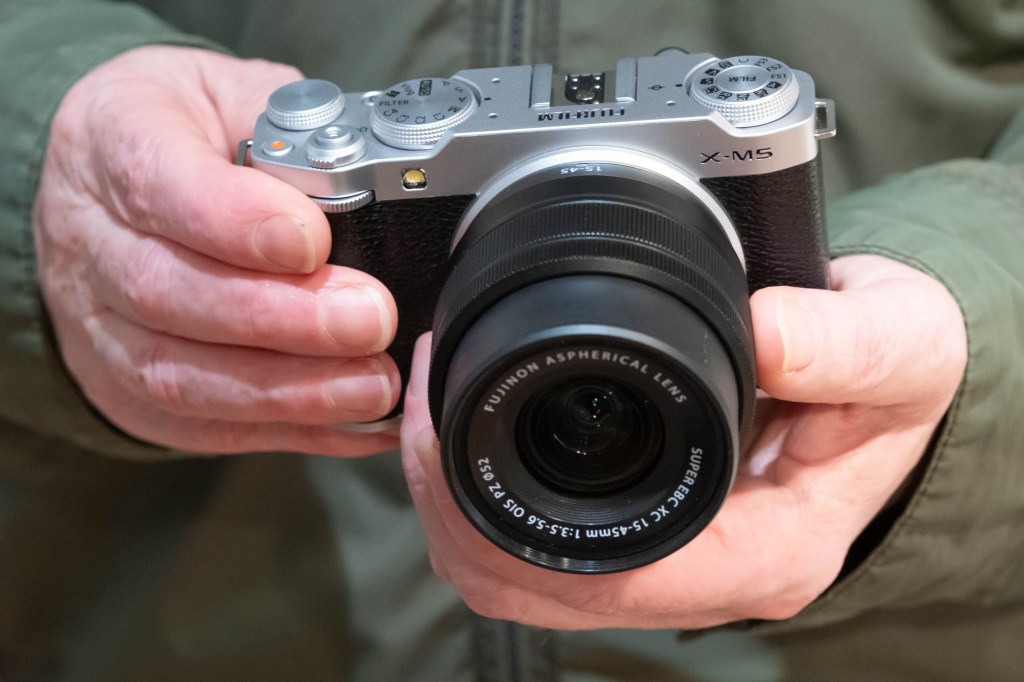
For a sub $800/£800 camera (body-only), it’s very impressive. To have pretty much the same image quality as the excellent X-S20, as well as some advanced specifications such as subject-detection autofocus, is a clear winner.
The small size of the camera is a good thing on the whole, particularly for those who don’t want to cart around heavy gear. But there are some compromises to consider – the button layout can at times lead to accidental settings changes (especially when you’re new to the camera), and if you ever want to use larger lenses, it’ll probably feel a bit awkward. But, pair the X-M5 with appropriate glass and you’ve got a lovely little shooting companion.
For now at least, the SLR-style X-T30 II remains on sale, and it’s currently about the same price as the X-M5. You don’t get so many advanced specifications, but you do get a viewfinder and a slightly more comfortable body.
If I were buying, that would probably be the one I’d go for. But if you’re not so worried about that kind of shooting experience, the X-M5 is a great choice.
Further reading:
- Fujifilm GFX100 II in-depth review
- Fujifilm X-T5 review – A 40MP mirrorless sensation
- The best lenses for Fujifilm

Follow AP on Facebook, Instagram, YouTube and TikTok.
Fujifilm X-M5: Full Specifications
| Sensor | 26.1MP X-Trans CMOS 4, 23.5 x 15.6mm |
| Output size | 6240 x 4160 |
| Focal length mag | 1.5x |
| Lens mount | Fujifilm X |
| Shutter speeds | 30sec – 1/4000sec (mechanical), 30sec – 1/32000sec (electronic) |
| Sensitivity | ISO 125-12,800 (standard); ISO 25,600 (extended) |
| Exposure modes | PASM, Auto, video, vlog, creative filter |
| Metering | Multi-spot, centre-weighted, average |
| Exposure comp | +/-5EV in 0.3EV steps |
| Continuous shooting | 8fps (mechanical), 20fps (electronic), 30fps (1.25x crop) |
| Screen | 3in 1.04m-dot fully articulated touchscreen |
| Viewfinder | None |
| AF points | 117 or 425 |
| Video | 6.2K 3:2 30fps; 4K 60fps; Full HD 120fps; up to 200Mbps |
| External mic | 3.5mm stereo |
| Memory card | UHS-I SD |
| Power | NP-W126S rechargeable Li-ion |
| Battery life | 330 shots; 440 shots in Eco mode; |
| Dimensions | 111.9 x 66.6 x 38mm |
| Weight | 355g |

